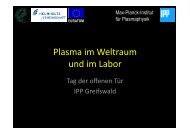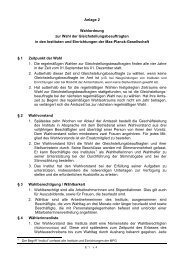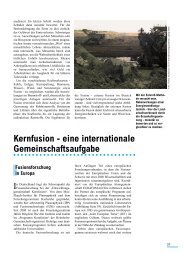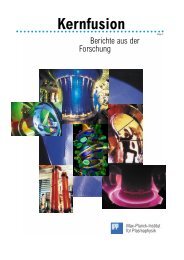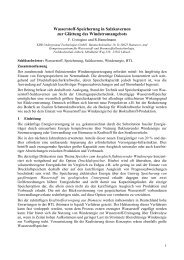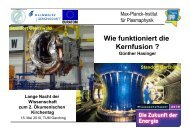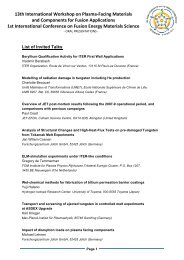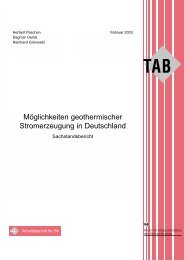IPP Annual Report 2007 - Max-Planck-Institut für Plasmaphysik ...
IPP Annual Report 2007 - Max-Planck-Institut für Plasmaphysik ...
IPP Annual Report 2007 - Max-Planck-Institut für Plasmaphysik ...
Create successful ePaper yourself
Turn your PDF publications into a flip-book with our unique Google optimized e-Paper software.
Helmholtz Junior Research Group<br />
“Computational Material Science”<br />
Head: Dr. Ralf Schneider<br />
The group studies effects on materials in contact with fusion<br />
and low-temperature plasmas. The major objective is the<br />
development and application of computational physics tools.<br />
Development of a Multi-scale Model for the Interaction of<br />
Hydrogen with Graphite<br />
The multi-scale model was extended further by including the<br />
formation and destruction of hydrogen molecules and the chemical<br />
reactions between hydrocarbons and hydrogen (Küppers-<br />
Hopf cycle). The model has been applied to study hydrogen<br />
retention and release from deposits collected from the leading<br />
edge of the neutralizer of Tore Supra. The simulations showed<br />
that the macropores play the dominant role in the retention and<br />
release behavior of hydrogen. The hydrogen released from<br />
the micropores and mesopores is adsorbed on the surfaces of<br />
the macropores. This internal deposition of hydrogen increases<br />
the tritium retention problem for carbon in a fusion reactor.<br />
Atomistic Description of the Plasma-wall Interaction using Ab<br />
Initio Methods<br />
Highly accurate global potential energy surfaces for C2H +<br />
3 and<br />
C2H +<br />
5 were generated using cluster expansions. They agree<br />
well with spectroscopic frequencies within several cm-1 .<br />
Density Functional Theory methods were applied to study<br />
the diffusion of atomic hydrogen trapped within crystalline<br />
graphite. The ab initio molecular dynamics calculations at<br />
10 K and 300 K show that the H atom forms a chemical bond<br />
with one of the C atoms in graphite. At these temperatures<br />
the H atom is not able to overcome the barrier and thus is<br />
not able to diffuse. These results drastically differ from<br />
those obtained by the use of the empirical Brenner potential<br />
where the H atom is able to diffuse freely. The potential<br />
energy curves calculated using the Brenner potential show a<br />
flat potential in the central region between graphite planes<br />
whereas for DFT calculations a higher potential energy<br />
region between the two planes is observed due to the contribution<br />
from the non-local pseudo-potential energy term.<br />
Kinetic Modelling of Complex Plasmas<br />
Kinetic modelling of plasmas with PIC (Particle-in-Cell)<br />
methods was done in close collaborations with experiments<br />
at the Ernst-Moritz-Arndt University in Greifswald within<br />
the Transregio TR-24 project. Calculation of spatial-temporal<br />
emission profiles in RF-discharges in oxygen including<br />
the formation of negative ions and comparison with experiments<br />
allowed for an estimate of the heavy ion collision<br />
cross-section for dissociative excitation of atomic oxygen<br />
+ by energetic O2 . The oxygen molecular ions get their maximum<br />
energy at the electrode after crossing the sheath.<br />
Theoretical Plasma Physics<br />
91<br />
Figure 4: Distribution of the plasma potential in an azimuthal segment for<br />
quasi steady-state in SPT-100. The fluctuations are clearly visible.<br />
PIC-modelling of electric propulsion Hall thrusters (SPT-100)<br />
demonstrated the importance of secondary electron emission<br />
for the operation of this system: electrons emitted from<br />
the surface of the SPT-100 have lower energies than the<br />
impinging ones. They leave the walls on a different spiral<br />
trajectory which is displaced towards the anode. This creates<br />
a high density low energy layer close to the walls which<br />
increases the electron conductivity strongly in this region.<br />
Another reason for electron cross field transport and axial<br />
currents beyond classical estimates are azimuthal fluctuations,<br />
which were visible in the simulations.<br />
Figure 5: Time evolution of the azimuthal profile of the plasma potential in<br />
the center of the discharge channel. The propagation of the fluctuations<br />
can be seen.<br />
Scientific Staff<br />
K. Matyash, A. Rai, R. Schneider, A.R. Sharma, F. Taccogna.




